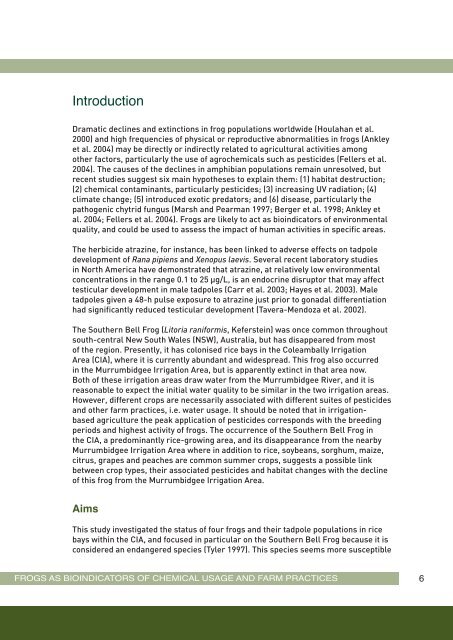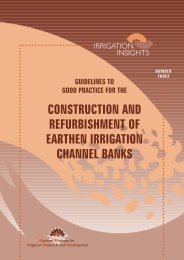Frogs as bioindicators - Land and Water Australia
Frogs as bioindicators - Land and Water Australia
Frogs as bioindicators - Land and Water Australia
Create successful ePaper yourself
Turn your PDF publications into a flip-book with our unique Google optimized e-Paper software.
Introduction<br />
Dramatic declines <strong>and</strong> extinctions in frog populations worldwide (Houlahan et al.<br />
2000) <strong>and</strong> high frequencies of physical or reproductive abnormalities in frogs (Ankley<br />
et al. 2004) may be directly or indirectly related to agricultural activities among<br />
other factors, particularly the use of agrochemicals such <strong>as</strong> pesticides (Fellers et al.<br />
2004). The causes of the declines in amphibian populations remain unresolved, but<br />
recent studies suggest six main hypotheses to explain them: (1) habitat destruction;<br />
(2) chemical contaminants, particularly pesticides; (3) incre<strong>as</strong>ing UV radiation; (4)<br />
climate change; (5) introduced exotic predators; <strong>and</strong> (6) dise<strong>as</strong>e, particularly the<br />
pathogenic chytrid fungus (Marsh <strong>and</strong> Pearman 1997; Berger et al. 1998; Ankley et<br />
al. 2004; Fellers et al. 2004). <strong>Frogs</strong> are likely to act <strong>as</strong> <strong>bioindicators</strong> of environmental<br />
quality, <strong>and</strong> could be used to <strong>as</strong>sess the impact of human activities in specific are<strong>as</strong>.<br />
The herbicide atrazine, for instance, h<strong>as</strong> been linked to adverse effects on tadpole<br />
development of Rana pipiens <strong>and</strong> Xenopus laevis. Several recent laboratory studies<br />
in North America have demonstrated that atrazine, at relatively low environmental<br />
concentrations in the range 0.1 to 25 μg/L, is an endocrine disruptor that may affect<br />
testicular development in male tadpoles (Carr et al. 2003; Hayes et al. 2003). Male<br />
tadpoles given a 48-h pulse exposure to atrazine just prior to gonadal differentiation<br />
had significantly reduced testicular development (Tavera-Mendoza et al. 2002).<br />
The Southern Bell Frog (Litoria raniformis, Keferstein) w<strong>as</strong> once common throughout<br />
south-central New South Wales (NSW), <strong>Australia</strong>, but h<strong>as</strong> disappeared from most<br />
of the region. Presently, it h<strong>as</strong> colonised rice bays in the Coleambally Irrigation<br />
Area (CIA), where it is currently abundant <strong>and</strong> widespread. This frog also occurred<br />
in the Murrumbidgee Irrigation Area, but is apparently extinct in that area now.<br />
Both of these irrigation are<strong>as</strong> draw water from the Murrumbidgee River, <strong>and</strong> it is<br />
re<strong>as</strong>onable to expect the initial water quality to be similar in the two irrigation are<strong>as</strong>.<br />
However, different crops are necessarily <strong>as</strong>sociated with different suites of pesticides<br />
<strong>and</strong> other farm practices, i.e. water usage. It should be noted that in irrigationb<strong>as</strong>ed<br />
agriculture the peak application of pesticides corresponds with the breeding<br />
periods <strong>and</strong> highest activity of frogs. The occurrence of the Southern Bell Frog in<br />
the CIA, a predominantly rice-growing area, <strong>and</strong> its disappearance from the nearby<br />
Murrumbidgee Irrigation Area where in addition to rice, soybeans, sorghum, maize,<br />
citrus, grapes <strong>and</strong> peaches are common summer crops, suggests a possible link<br />
between crop types, their <strong>as</strong>sociated pesticides <strong>and</strong> habitat changes with the decline<br />
of this frog from the Murrumbidgee Irrigation Area.<br />
Aims<br />
This study investigated the status of four frogs <strong>and</strong> their tadpole populations in rice<br />
bays within the CIA, <strong>and</strong> focused in particular on the Southern Bell Frog because it is<br />
considered an endangered species (Tyler 1997). This species seems more susceptible<br />
FROGS AS BIOINDICATORS OF CHEMICAL USAGE AND FARM PRACTICES<br />
6
















